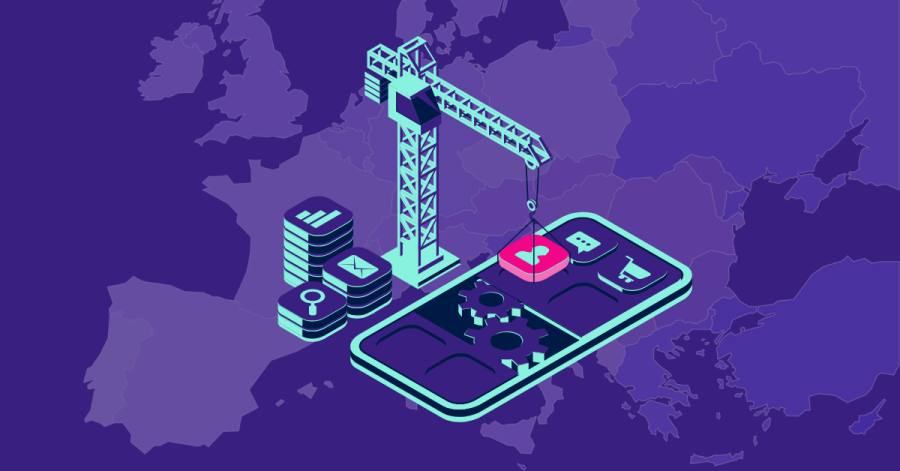Mobile app development in Central and Eastern Europe is growing fast. Digitalization and increasing smartphone use are driving this change.
What sets CEE apart? It combines increasing mobile adoption, the rapid rollout of 5G, and a unique ability to adapt to challenges. On the other hand, Western Europe offers lessons in maturity: its markets have refined user experiences, advanced monetization strategies, and omnichannel capabilities. Understanding these differences is vital for marketers, product managers, and business owners.
CEE and Western Europe may seem like two different worlds, but they offer a roadmap for anyone looking to succeed in the mobile-first era.
Mobile app development in CEE
The mobile ecosystem in Central and Eastern Europe is expanding exceptionally. Mobile data traffic in the region is projected to grow fivefold by 2026, a rate outpacing Western Europe and North America. A few key drivers are behind this:
-
- Smartphone penetration: Affordable and accessible smartphones brought millions of users online. For example, Poland has one of the highest smartphone adoption rates in the region, with 93% of its population connected.
- 5G rollout: Countries like Romania actively deploy 5G networks to enable faster connectivity and better app performance.
- Mobile-first solutions: From e-commerce in Hungary to mobile banking in the Czech Republic, CEE countries transform their digital landscapes.
CEE’s mobile app ecosystem highlights
CEE’s app ecosystem is diverse, but some trends stand out:
Popular app categories:
-
- Mobile gaming remains a top choice in CEE, with high engagement across the region. In Poland, for example, the mobile gaming sector saw app installs grow by 30% year-over-year. Apps integrating gamified features see a 47% increase in engagement rates during peak shopping periods like Black Friday and Christmas.
- E-commerce apps also gained significant traction. In Hungary, installs doubled during the pandemic as more people turned to their phones for shopping, showing just how essential mobile solutions have become.
- Fintech is another thriving category. Romania has emerged as a leader in this space, with Revolut identifying Romania as its second-largest market globally and the largest within the EU.
Consumer behaviors:
-
- High engagement: Users in CEE tend to engage extensively with apps due to the convenience they provide for various aspects of daily life. As for in-app messages and stories, they result in 4x better retention rates compared to apps without these features.
- Growing spending: In-app purchases in the Czech Republic more than doubled from 2020 to 2021, highlighting a growing willingness to invest in mobile experiences.
- Cross-border usage: Many consumers use apps to access international markets, such as Estonia’s high usage of cross-border e-commerce platforms.
Regional Characteristics
CEE stands out from Western Europe in several key ways that make it a unique and promising market:
-
- Localized platforms: Unlike Western Europe, where global giants like Amazon dominate, CEE thrives on regional players such as Allegro in Poland and Emag in Romania. These platforms better match local culture and needs.
- Lower market saturation: Western Europe is competitive, but CEE offers more room for growth, especially in smaller markets like Croatia and Slovakia.
- Adaptability to change: CEE developers have shown great agility. Hungary’s app ecosystem, for example, adapted during the pandemic, leading to a 36% increase in in-app purchases. This surge reflects a broader trend in CEE, where in-app communication tools, such as shoppable videos, interactive stories, and gamified features, have been linked to a 27% increase in retention rates and longer session durations by up to 2x.
Challenges facing mobile development in CEE
Mobile development in Central and Eastern Europe comes with its own set of challenges. One of the most noticeable issues is a lack of digital skills in certain areas. Take Poland, for instance. While it’s often seen as a tech hub, there’s still a significant gap. Only 43% of its population meets the EU’s basic digital competency standard. That’s below average. And this isn’t just a tiny problem. It affects everything — from how quickly companies can build solid mobile apps to how fast industries can adopt mobile-first technologies.
Then there’s the issue of funding, which is another big challenge, especially for smaller markets. Slovakia is a good example here. Startups in the country often struggle to attract the kind of investments companies in Western Europe seem to access more easily. Without enough financial backing, it’s hard to keep up in innovation-heavy sectors like fintech or gaming.
One thing is clear: resources are stretched thin, and the gaps are hard to ignore. But that doesn’t mean they can’t be bridged. Companies can push forward and seize opportunities with thoughtful planning, partnerships, and creativity.
Navigating different languages, regulation and consumer habits
CEE’s diversity is both a strength and a challenge. Its varied markets offer opportunities but require careful planning and deep local understanding to navigate unique languages, rules, and habits.
-
- Language and localization: Take Romania, where the success of local e-commerce giant Emag is partly attributed to its deep understanding of regional preferences and effective localization.
- Regulatory challenges: Data privacy laws, payment regulations — each market has its own rules. Businesses need to adapt, and that’s no small task. It takes time. It costs money. And keeping up with all these requirements can feel like a constant challenge.
- Consumer behavior: Payment methods illustrate the complexity of the region. While mobile payments are widely used in Poland, cash-on-delivery still dominates in Hungary. A lack of uniformity in consumer habits adds another layer of difficulty for businesses looking to scale.
Businesses in CEE face many challenges, yet they’ve found smart ways to succeed. In Poland, for example, developers are experimenting with hybrid monetization. They’re combining in-app purchases, subscriptions, and ads. It’s not revolutionary, but it works! In 2021, this approach pushed in-app ad revenue up by a massive 230% compared to the previous year.
Gamification is taking fintech to a new level. In Romania, fintech apps are turning financial planning into a more interactive experience. They’ve added mini-games to make budgeting and saving fun. Younger users, in particular, enjoy these features.
Localization is another big win. Companies like Allegro in Poland and Pevex in Croatia are proving that understanding local needs can go a long way. They’ve even outperformed global giants like Amazon in their own markets.
These stories show one thing: businesses in CEE know how to adapt. They innovate. They find workarounds, even when resources are tight. And for other companies looking to tackle their own obstacles, there’s a lot to learn here.
How CEE compares to Western Europe
Western Europe and Central and Eastern Europe are at two very different points in their market development. Both have their upsides, but they also face unique challenges.
Western Europe’s mobile app ecosystem is mature and highly profitable. Growth has slowed — markets have hit a plateau — but they’ve found ways to make the most of their users. Take Germany, for example. In 2023, its e-commerce sector generated over 85 billion euros in B2C online sales. That’s a testament to its strong infrastructure and established consumer habits.
One area where Western Europe really shines is omnichannel retail. Brands have figured out how to connect digital and physical shopping into one smooth experience. Look at French platforms like Vinted. They mix online marketplaces with second-hand shopping, tapping into sustainability trends and modern consumer values. It’s clever and clearly working.
Meanwhile, in CEE, mobile adoption is rising fast. Romania saw a 31% jump in app installs in 2021, far outpacing many Western markets. CEE also leads in local innovation. Platforms like Poland’s Allegro succeed by understanding what local consumers want. In many cases, they’re outperforming global giants like Amazon.
Finally, CEE’s flexibility is a significant advantage. Hungarian developers, for example, quickly embraced gamification and hybrid monetization during the pandemic to meet changing demands.
Little refining goes a long way
Western Europe and CEE represent two sides of mobile app development. CEE’s growth shows how far innovation and adaptability can go. On the other hand, Western Europe is all about consistency and smooth user experiences there. For businesses, the path forward lies in combining these strengths. Stay bold and creative, but don’t overlook the power of refining what works. And yes, small touches like in-app engagement features can go a long way because they’re about building meaningful connections.
In the end, success in mobile development isn’t only about technology. It’s about people. Whether in CEE or Western Europe, understanding their habits and delivering what they need will always make a difference.








